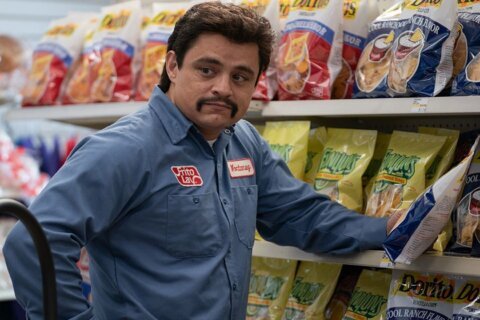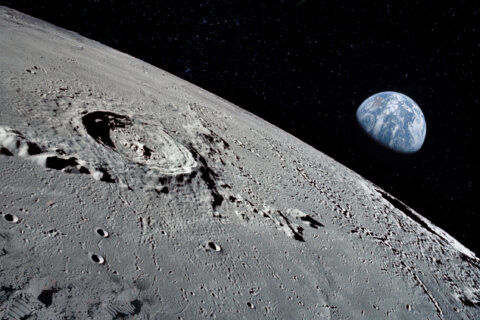WASHINGTON — Never underestimate the popcorn prowess of director Steven Spielberg.
Just when you thought his latest trailer appeared silly, you’ll be pleasantly surprised at how the master wins us over with comforting story structure and giddy pop culture references for an experience that, while derivative and overstaying its welcome, is undeniably enjoyable.
Set in the year 2045, it’s less a sleek “Minority Report” future than a dystopian trash heap known as The Stacks. In these harsh conditions, many folks prefer to escape to a virtual reality world called the OASIS, where you can create an avatar and play out your wildest dreams.
When the genius creator Halliday (Mark Rylance) dies, a posthumous video challenges players to find his “Easter egg,” a secret element hidden within the digital world. Whoever finds it will inherit his fame and fortune, as well as total control of the OASIS. Shy teen Wade Watts (Tye Sheridan) accepts the challenge, but he must compete against a corrupt corporation led by C.E.O. Sorrento (Ben Mendelsohn), who wants to absorb the OASIS to monopolize his power.
It’s been fun watching Sheridan grow from child star in “The Tree of Life” (2011) and “Mud” (2012) to a leading (young) man here. Shifting from his live-action Wade to his motion-capture Parzival, Sheridan acts circles around Sam Worthington in “Avatar” (2009), while Olivia Cooke matches the pathos of Zoe Saldana’s Neytiri. After such indies as “Me and Earl and the Dying Girl” (2015) and “Thoroughbreds” (2018), Cooke earns new mainstream appeal with a dual role, juxtaposing her confident avatar Art3mis with the insecurity of her live-action Samantha.
As for the adults in the room, Mendelsohn is a compelling baddie whose comeuppance is more nuanced than expected, showing the actor’s range after his subtly stuttering king in “Darkest Hour” (2017). Still, the best performance belongs to Mark Rylance, who reunites with Spielberg after his Oscar in “Bridge of Spies” (2015). Here, he plays the OASIS creator like a mix of Steve Jobs, Garth from “Wayne’s World” and Gene Wilder handing out golden tickets.
Yes, there’s a “Willy Wonka” charm to the premise with easy-to-follow stakes. Co-written by Zak Penn (“Last Action Hero”) and source novelist Ernest Cline, the plot smartly tasks its characters to solve three puzzles to obtain three keys en route to the Easter egg. Like Link gathering pieces of the Triforce in “Zelda,” these plot points give the film a video game feel, while providing a built-in structure that moves in one direction rather than subplot tangents.
The first puzzle is a thrilling street race through New York City. If you’ve ever wanted to watch the DeLorean race against King Kong and a T-Rex, this is your movie. As Kong pounds the pavement, it feels like you’re on a Universal Studios ride, while the revving engines and green lights recall “Mario Kart,” revealing a clue to crack the code like a “Super Mario” warp pipe.
The second puzzle is a trip down movie memory lane with an elaborate homage to Stanley Kubrick’s “The Shining” (1980). We get all of the haunts of the Overlook Hotel: ghostly girls, a bloody flood, the writers-block typewriter, door ax, hedge maze and the horrors of Room 237. Even the famous black-and-white ballroom photograph splits in half for a symbolic clue.
The third and final puzzle involves a nostalgic array of Atari games, ranging from “Centipede” to “Adventure.” While the ultimate reveal is perfectly fitting, it takes entirely too long to get there with a climax that drags during an all-out White Walker-style war that becomes so indulgent with Iron Giants and Chucky dolls that not even the Holy Hand Grenade can save it.
In this way, the pop culture references occasionally feel forced, namely a “Saturday Night Fever” dance sequence. Later, there’s a hint of “The Searchers” and “Star Wars” when Wade finds the torched home of his aunt, whom he clunkily calls his “mother’s sister.” By the time we get a direct quote from Lex Luthor in “Superman,” we’re reminded that many of the film’s most clever ideas don’t belong to it, but rather are purged from other previous creations.
(Granted, the “Superman” quote remains one of the most underrated lines in movie history: “Some people can read ‘War and Peace’ and come away thinking it’s a simple adventure story. Others can read the ingredients on a chewing gum wrapper and unlock the secrets of the universe.”)
Still, no matter how derivative, it’s all so reverential that Spielberg’s loving homages are contagious. This is particularly the case with his repeated “Back to the Future” nods, as Sheridan not only drives a DeLorean, but solves a Rubik’s Cube that is affectionately dubbed a Zemeckis Cube. If you listen closely, you’ll even hear composer Alan Silvestri revive his magical jingle motif that Marty McFly heard each time Doc Brown said, “Erased … from existence.”
By most fan accounts, the film is a marked improvement over the book, in which Wade Watts lived in Oklahoma City before Spielberg changed it to his own native Ohio. This is Spielberg’s show now — and we’re all better for it. So if you liked the book, there’s a good chance you’ll love the movie. And if you were skeptical of the movie, you might just be pleasantly surprised.
Even the most hardened of cynics can appreciate the take-away message: it’s important to live in reality because it’s the only thing that’s real and the only place you can get a decent meal.









